DNA results can be overwhelming for someone new to the world of DNA testing. In this post, I will explain to you the different aspects of your My Heritage DNA test results and help you get the most of your DNA results.
You got the e-mail letting you know that your My Heritage DNA results are ready, and you are logged in. Now what?
Ethnicity estimates, DNA matches, and chromosome browsers? Where should you start?
By the end of this article, you will have learned:
- Where to click to access the various aspects of your My Heritage DNA results
- What your ethnicity estimate really means
- How to understand your My Heritage DNA matches
- What to do now that you have explored your results
In order to explain the DNA results you have received from My Heritage DNA, I will take you on a tour of my own relative's DNA results. I opened them for the first time while I was putting together this post - so exciting! (Read about why it is good to ask more relatives to take a DNA test)
Basics of your My Heritage DNA results
When you first log in to your My Heritage account, you should click on the DNA tab at the top of the screen. Alternatively, you can click on the little DNA icon that is at the top left of the screen:

The website will now display a "card" with a summary of your DNA results, along with links to your ethnicity estimate and your DNA matches. You can click on the "View Full Estimate" in order to see your full ethnicity estimates.
The information included on this summary will only show your most prominent ethnicity, but in order to see your smaller ethnicities, you will have to click through to see the whole full estimate.
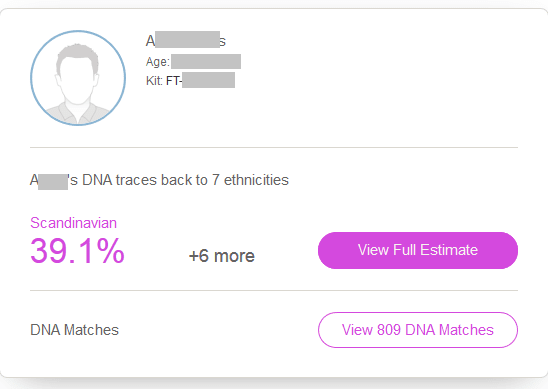
If you want to see your DNA matches, you should click on the "View (number will vary) DNA Matches". This will take you to another screen where you can scroll through and see all of the people who have also tested with My Heritage DNA (or have uploaded their DNA there from other testing companies) who share genetic material with you.
What does your My Heritage DNA ethnicity estimate mean?
You don't share DNA with each and every distant ancestor, but you did inherit DNA from many of them. Each child inherits 50% of their DNA from each parent - this is easy enough to understand.
But what this also means is that with each generation, 50% of the DNA from each parent gets "left behind" and not passed down through that line. Your ethnicity estimate is basically an estimate based on a summary of the DNA that you did inherit.
My Heritage DNA has a "reference population" that is made of up people from many different geographic areas that have verified, deep roots in that area. The idea is that this reference population gives a good idea of what DNA from that region should "look like".
Your DNA is then compared with the DNA from those regions, and you are given an estimate that tells you how much of your DNA matches that particular part of the world.
Each company has their own unique reference populations and some companies focus more on one part of the world than others. The My Heritage DNA is a relatively accurate representation of how much of your DNA matches the particular geographic regions that they test for, remembering, of course, that only DNA that you actually inherited is available for comparison.
It's possible to have inherited absolutely no DNA from an ancestor about 5-7 generations back, so keep that in mind if there is a particular ethnicity you were expecting to see.
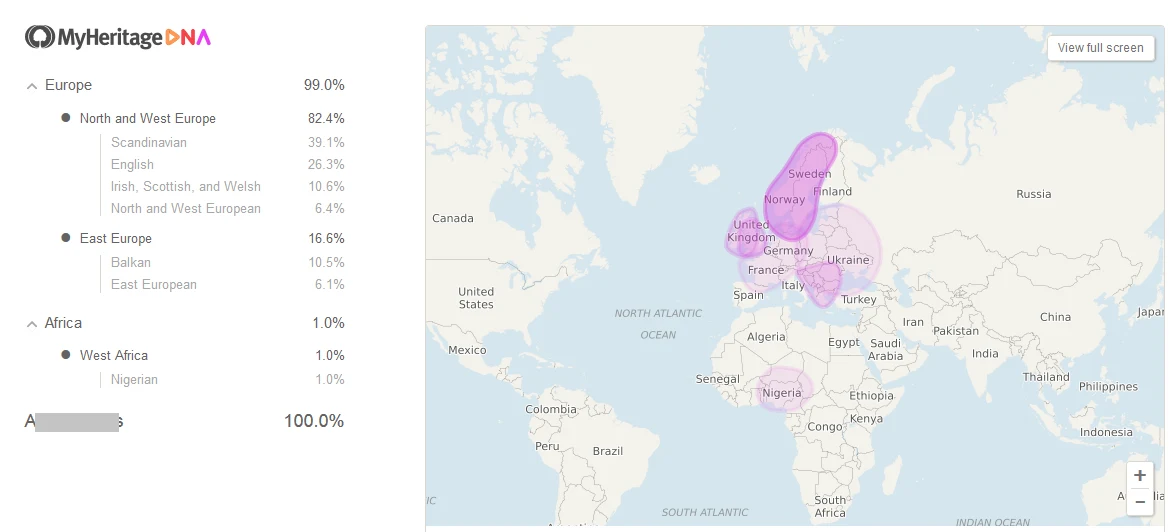
Something that I only recently noticed with My Heritage is that if you click on any of the regions that are highlighted for you, a little icon will appear underneath the map that says "Play Tune".
If you click this, the website will play a clip from typical regional music sample. I think this is a thoughtful way for them to help us connect a bit with the culture of our ancestors.
It's a small gesture, but it makes it seem more tangible somehow.

How to understand your My Heritage DNA matches
One of my favorite aspects of DNA testing is the amazing capability of these tests to match us to living DNA relatives around the world. Most of us know personally our "immediate" family (brothers, sisters, parents), and many of us are familiar with our aunts, uncles, grandparents, and first cousins.
The lucky few of us were able to know more extended family, like great-aunts, great-grandparents, or second cousins. It would be impossible to have met all of your DNA relatives, or even know who they are - and that's why these DNA tests are so cool.
It's a chance to meet people that share a unique connection with you.
Even if you aren't interested in being in contact with your DNA relatives, there is so much you can learn from your DNA matches. You can figure out if your family tree research is correct, exchange information, photographs and documents with your distant cousins, and learn more about your family's ancestry.
How to access your My Heritage DNA matches
To access your My Heritage DNA matches, just click the "View (# of) DNA Matches" from the your main DNA dashboard. Everyone will have a different number of DNA matches, and your number might change based on the number of people who do tests with My Heritage or transfer their DNA there from another testing company.
On the screen where you can see your list of DNA matches, you will be able to scroll down through your matches. The default way the list is presented to you is by Shared DNA, meaning that the person who shares the highest amount of DNA with you will be listed first, and then the rest of your matches will be displayed in descending order (gradually sharing less and less DNA with you).
You can change the way that the DNA is sorted by clicking the little down arrow next to where is says "Shared DNA". You can change it to a specific name, request to see the most recently added matches, or see people listed in order of DNA segment size (which can be a good measure of how distant your common ancestor is).
To investigate a match, click on the purple "Review DNA Match" button. Alternatively, you can click on the "View Tree" button to check our your match's family tree, if they have one (not everyone has built a tree on the site).
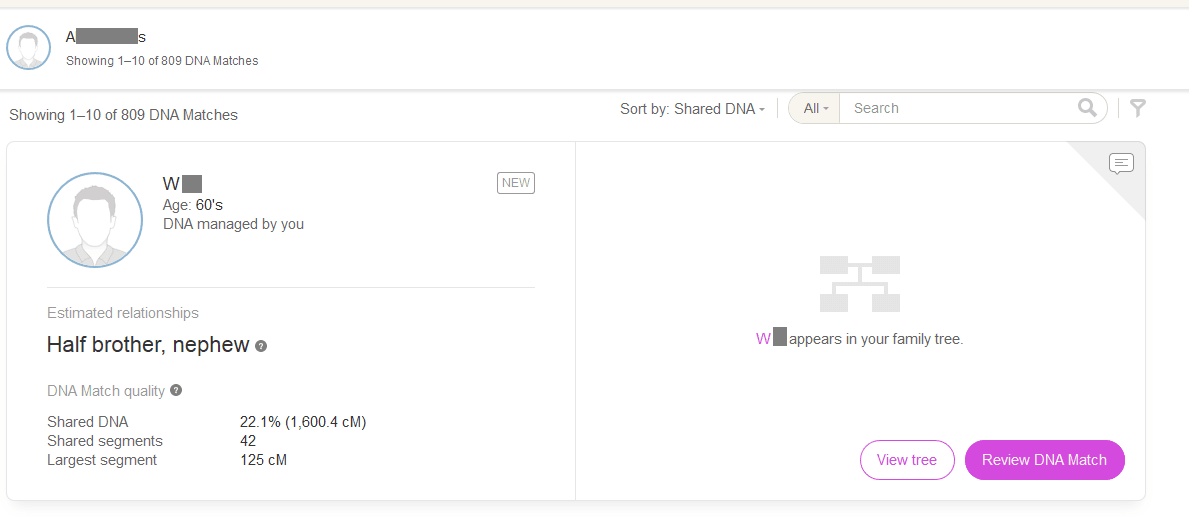
What can you learn by reviewing your My Heritage DNA matches?
The process of reviewing your My Heritage DNA matches can reveal quite a bit about your match and how might potentially be related to each other. There are several aspects of your shared DNA and estimated relationship that you should look for:
- Your match's name can reveal quite a bit about your relationship. You might recognize the surname, especially if it is a relatively close match
- The estimated relationship can be useful, but it is only an estimate based on the total amount of DNA you share, the number of shared segments, and the length of the longest segment
- The total number of DNA is first expressed as a percentage, and then in centimorgans. Centimorgans is the unit of measurement that geneticists use to measure DNA segments. Generally speaking, the more centimorgans (cMs) of DNA that you share with someone, the closer the relationship, and the more recent the common ancestor
- The total number of DNA segments that you share with a match can also provide clues about your relationship. Closer relationships will typically share many DNA segments of varying sizes.
- The best clue as to how close your relationship is to a match is the length, in cMs, of the largest DNA segment that you are. In the example below, you can see that my relative shares a segment of 125 cMs with his nephew. This is a nice, long segment and implies a very close relationship. Segments get passed down almost completely intact from parent to child, but each generation, they are broken up more and more.
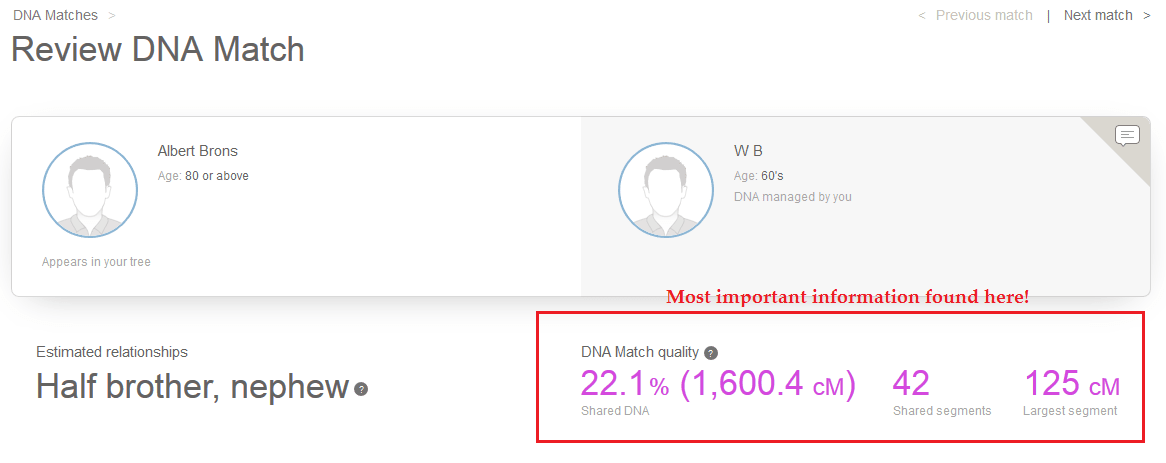
What do shared matches mean on My Heritage?
If you scroll down a little bit when you are reviewing your DNA match, you'll find a list of shared DNA matches. Checking through your shared matches can be a helpful way to determine how you are related to your match.
At the top of the shared match section, you will see how many shared matches you share with this match. In the case of the example below, the test taker and the match share 66 shared matches.
You will share more matches in common with closer relatives. The more distantly related you are to your match, the less likely it will be that you have matches in common.
On the left side of the shared match column, you can see the estimated relationship to the test taker, and on the right side, you can see the estimated relationship to the match that you are reviewing.
In the middle, you can view the amount of shared DNA both you and the match that you are reviewing share with the shared match. This can help you figure out where everyone lies in the family tree.
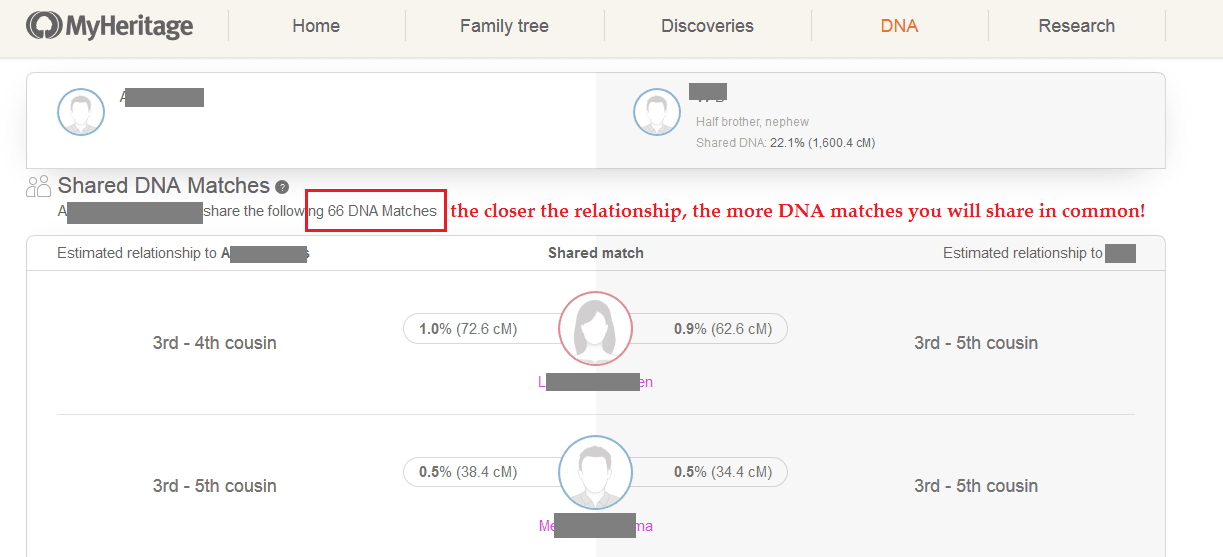
A word of caution is in order when it comes to shared matches. Shared matches can imply that you are all three (both you, your match, and your shared match) related through the same common ancestor.
Many times, this is absolutely the case. Other times, it's possible for you and your DNA match to be related to each other in different ways.
For example, maybe you and your shared match are related through your great-grandmother, Ester's dad. And maybe your DNA match is also related to the shared match through his father's Grandpa Joe.
You share the DNA match, true, but it doesn't always mean that it's a slam-dunk - you might be all related through the same person on the family tree.
Shared ethnicities with DNA matches on My Heritage
This feature allows you to view which ethnicities you share in common with your DNA match. Sometimes, it's just kind of interesting to view this.
Other times, it can be useful - especially when you and your match only share one "trace" ethnicity with each other, which could imply that you are related through a common ancestor of this ethnicity.

How to view your DNA match's pedigree chart on My Heritage DNA
If you want to check out your DNA match's pedigree chart (where you can easily spot a potential common ancestor), just scroll down past your shared ethnicities. You can click on the "View Full Tree" link in the lower right-hand corner under their pedigree chart.
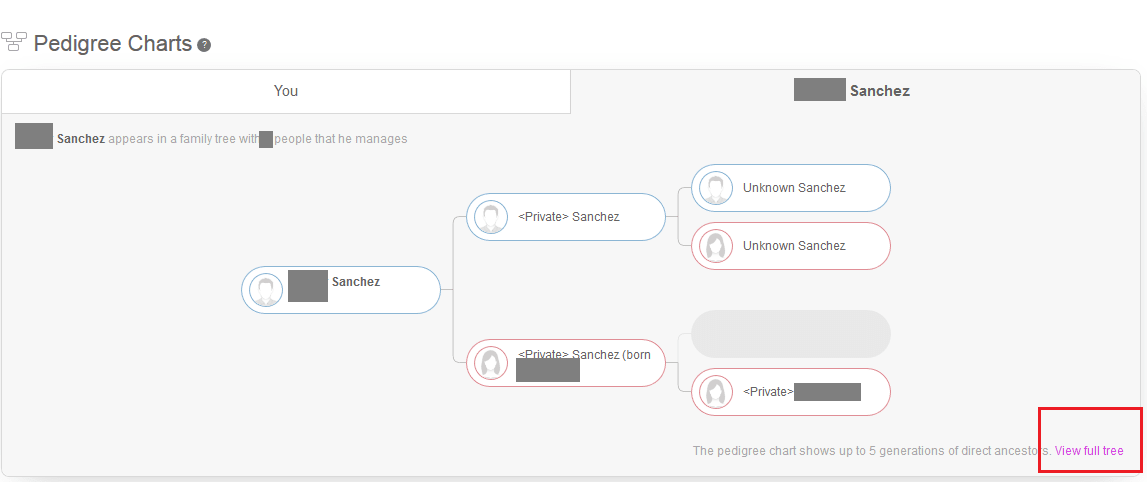
Your My Heritage DNA match and the chromosome browser
I love it when companies provide us with a chromosome browser. To me, it leads me to believe that the company respects my intelligence enough to provide me with the whole story.
A chromosome browser can look complicated at first, but it truly does reveal a wealth of information to those who are interested and want to learn. To access the chromosome browser on My Heritage DNA, just scroll down to the bottom of the page where you are reviewing a specific DNA match.
Below, you can see my great-uncle and father's DNA compared on the chromosome browser. The purple segments are shared DNA segments, and the white areas are places where they don't match.
How can I use this information? If I know exactly where the DNA segments are located, I can then match other relatives to those same DNA segments and learn more about our common ancestors.
It can get a little hairy, but it's fun! And I'm glad it is there for those of us who are interested in getting our hands a little dirty with the science.
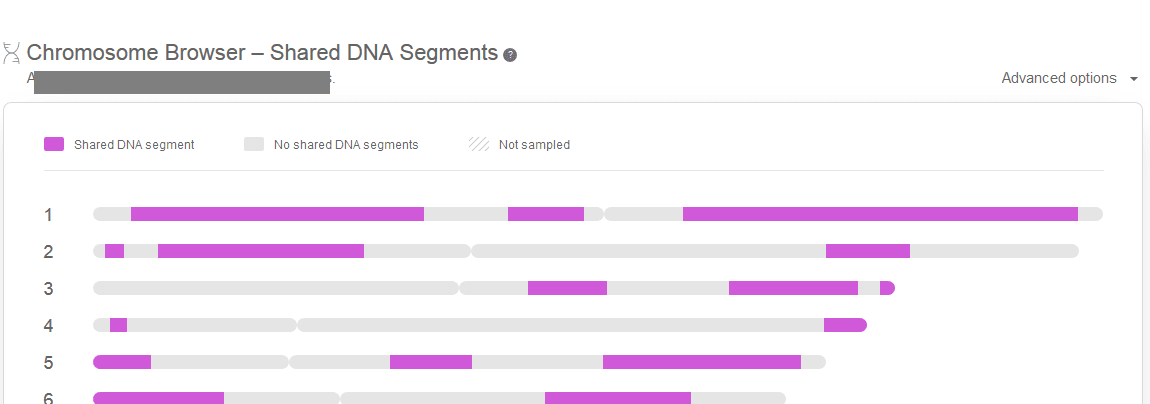
Do you need to take a My Heritage DNA test?
If you haven't yet taken a My Heritage DNA test and you would like to, or you need to get another test for an older family member (highly recommended), you can get your test easily using the link below.
Uncover your ethnic origins and find new relatives with the My Heritage DNA test!
Conclusion
I hope that this post helped you understand the basics of how to understand your My Heritage DNA results. If you have any questions, comments, concerns, or would like to share your experience with My Heritage, please feel free to leave a message in the comments.
Thanks for stopping by!


Melissa Jackman
Friday 20th of May 2022
Thank you, I wonder how I've managed to inherit 48% Scandinavian DNA when neither of my parents is Scandinavian - unless I have 25% from each - I've inherited chunks which have been passed to them in chunks?
Kathleen Edgar
Tuesday 13th of April 2021
My Heritage did my dna test a few years ago and I updated but have no dna info
MorrMMMMMMie
Monday 27th of April 2020
G'day Mercedes, What can I say, just VERY well presented. I learned a lot. It's a pity MYH doesn't tell you how complicated it is to read DNA. It would help if they gave clear and concise instructions (like you). Can I make a suggestion, for you to make a mini dictionary of the terms used in DNA matching, MYH assumes you know all words. No one seems to have thought of that. Please let me know if you get time to do this. Thanks. Ooaroo - Morrie, Australia
Mercedes
Friday 8th of May 2020
This is a fantastic idea - I will see if I can put something like this together. I appreciate your comment and the suggestion :) Mercedes